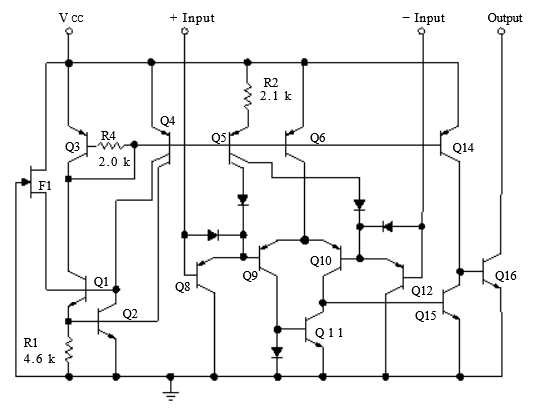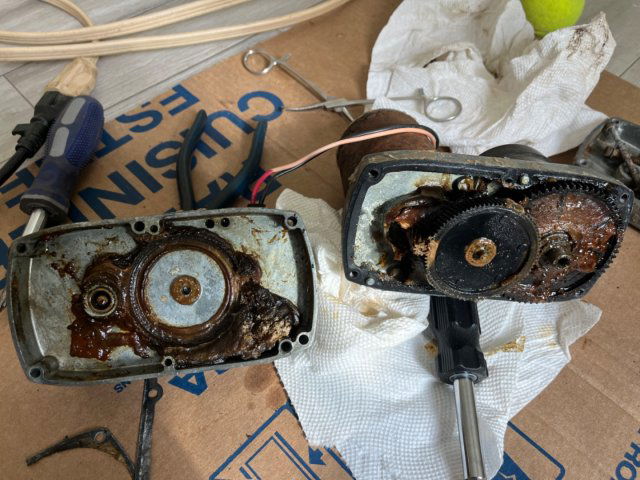New user - old Birdview
- Thread starter bombu
- Start date
- Latest activity Latest activity:
- Replies 86
- Views 4K
You are using an out of date browser. It may not display this or other websites correctly.
You should upgrade or use an alternative browser.
You should upgrade or use an alternative browser.
I
There's still the other half of the box yet to be opened.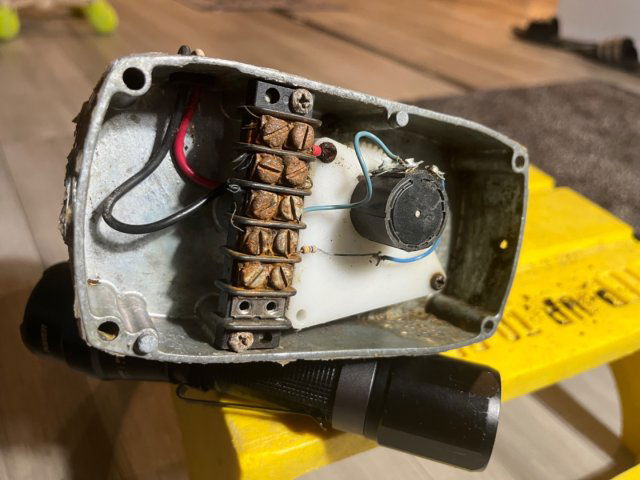
I'm back sooner than I had anticipated. Here's a picture of the gear box. It has a helipot precision potentiometer and plastic (nylon?) gears. I expected metal.I've ordered the LNBF and receiver. Thanks very much to all of you who helped me out! I will continue here once I have made some progress.
There's still the other half of the box yet to be opened.

I
I'm back sooner than I had anticipated. Here's a picture of the gear box. It has a helipot precision potentiometer and plastic (nylon?) gears. I expected metal.
There's still the other half of the box yet to be opened.View attachment 181943
Like the rest of the hardware on the Birdview, welcome to "old school", original install, components from the 1980's.
Do you still have the original positioner controller to power and move the motor? You could upgrade the multi-turn potentiometer to either an optical sensor or reed switch, but really the 1st question is how you plan on controlling the dish position?
Yes, I'm pretty sure I have the original box that moved the dish. Can I find it is another question.That's normal, those used nylon gears. Probably a 10k 10-turn pot. Not worth trying to convert to reed switch.
I've been assuming that if I did get the dish movement motorized again that I would use the original controller. But I haven't been very hopeful about that being doable. I've mostly figured that I would just leave it pointed at one satellite. But those nylon gears look to be in good shape. I'll keep messing around with it. It looks like it's going to take some doing just to get the rest of the mounting cleaned and lubed enough to move at all all, which I probably have to do anyway, unless it happens to be aimed at a satisfactory satellite now.
I've got room enough so it might be more expedient to look for more old dishes to add later.
The original stuff is in a box in a shop building. It's a bit of a mess.I thought you said the original house and all was gone. Anyhow, I doubt you'd want to use anything but a newer actuator/positioner with reed sensor
The original stuff is in a box in a shop building. It's a bit of a messI thought you said the original house and all was gone. Anyhow, I doubt you'd want to use anything but a newer actuator/positioner with reed sensor
That looks nice. What is that sensor, exactly?
Never one to throw out potentially usable stuff. Telstar kind of hit a bone.The original stuff is in a box in a shop building. It's a bit of a mess
That looks nice. What is that sensor, exactly?
If it makes sense at all. If you can get the gearbox and actuator tube running good. Seeing that a potentiometer is in fact a positive feedback device that would provide an ancient dish mover without memory storage a positional signal. Meaning an analog to digital converter could change a resistance value to a numerical value on a display where you would then look for a satellite at position X from a cheat sheet.
Perhaps with limited memory slot storage.
Whereas a pulse generator like a reed switch with sector magnet triggers, hall devices with magnet wheel. Or like I'm using, an optical interrupter with slotted wheel. I believe the successor to potentiometer type feedback.
Thinking I have this subject splattered here and there on satguys. This is an experiment. You don't even know if and when you get your dish up and working. If scanning more than one satellite is feasible where you live. And a new, in the box actuator is going to be expensive. I really don't even know your level of mechancal/electrical skills. But the enthusiasm is tops. As well as your "getting your guns loaded" great questions.
I said that a very cheap but old dish mover could be had from eBay. Just a stand-alone unit that would drive the dish. Most I see use a reed switch. Twenty bucks.
The Amazon Arduino kits can even be found with interrupter wheels. For a few bucks. All you would need to do it pull the potentiometer from your gearbox. Fashion up a way to mount the optical wheel. Build a bracket to mount an optical switch. And providing you have a 3 wire cable for the sensor at the motor and inside. The rest is easy. Maybe dig up an old wall wart charger to give the optical sensor juice.
And looking at the schematic from one of the Amazon kits. Know anything about electronics? Well, take a peek.
In it's current configuration, OUT and ground provide a voltage that comes from Vcc when the sensor is (thinking) unblocked.
Kind of cool. But pay attention to the LM393 comparator on the optical module. Next image.
On the sensor module is the LM393 comparator IC. And it's configured as a current source. Beam is unblocked, the LED lights and voltage appears between the Out and ground (pretty sure....need more coffee. Anyway).
Below, look at Q16. Internal to the IC. Q16 is your switch. Reed switch contacts if you had one in the gearcase.
Optical wheel spinning turns the switch on and off.
Now. There are several ways to make this work. Easily. My configuration is a bit different. Uses an external solid state relay.
In the simplest form. You get the thing working in your gearcase. And snip the 10k and possibly the 1k resistors by the LED indicator.
And test with a multimeter.
No new actuator. No hunting for the right magnet. No playing around with finding a sweet spot to put a reed sensor that may or may not play nice.
You slice that light beam. You get switching action. Every single time.
And it opens the possibility at a later time to add a vbox dish mover that interfaces with a receiver to move the dish when you change satellites on the receiver.
I just spent 27 bucks of your money. Sure beats tossing the actuator for a new one. Ya' think?
View attachment 181984
Attachments
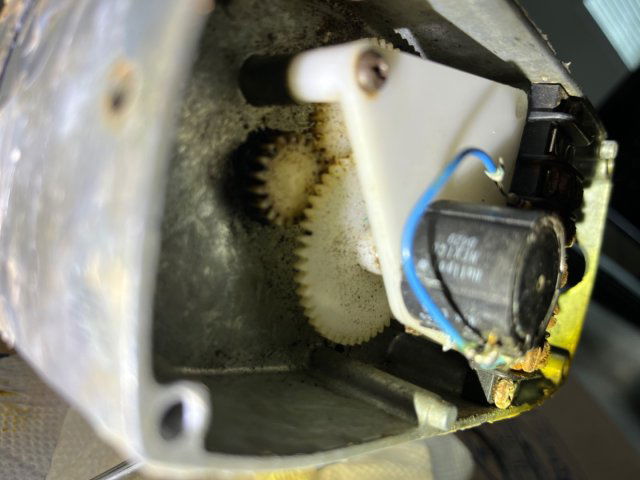 I removed two screws from inside the gearbox which allowed me to open the other half of the box just a little. Water poured out.
I removed two screws from inside the gearbox which allowed me to open the other half of the box just a little. Water poured out.I don't know what is still holding it together. Am I going to have to remove the nylon gears? I removed the two long screws from the motor. Should the motor be free then? It's so rusty it's likely stuck but I don't want to try to force it if there's still something else to remove first.
I realize nobody is likely to have experience with this exact part but I would appreciate any feedback.
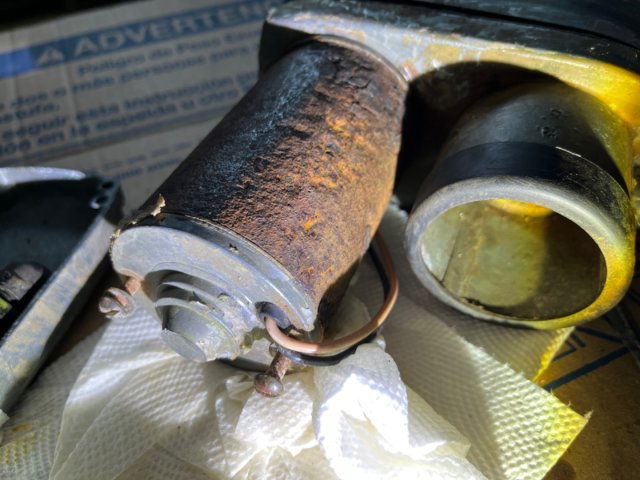
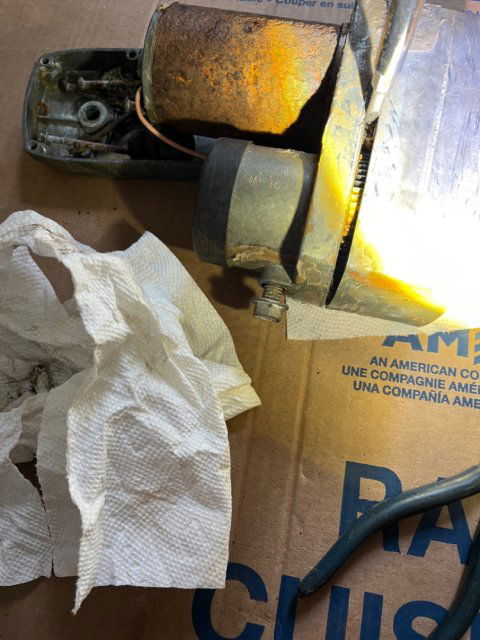
I believe that is an Optical Interrupt sensor. Counts position by breaking light beam. Like the pot sensors, and also Hall-Effect sensors, a long-ago obsoleted use.
This arm is good for one thing only, maybe- if it doesn't have any free play it could serve to fix the dish on a desired position by extending/retracting the body of it through its mount bracket if the bolts can be loosened/tightened or replaced.View attachment 181990I removed two screws from inside the gearbox which allowed me to open the other half of the box just a little. Water poured out.
I don't know what is still holding it together. Am I going to have to remove the nylon gears? I removed the two long screws from the motor. Should the motor be free then? It's so rusty it's likely stuck but I don't want to try to force it if there's still something else to remove first.
I realize nobody is likely to have experience with this exact part but I would appreciate any feedback.View attachment 181989View attachment 181988
Whoa, Nelly! For satellite usage, the vbox variants are the only kid in town. Reed switch sensors might be used because it's cheap and simple. If water poured out of the gearbox. Sorry. Nothing short of a complete teardown would be my next step. Motor, gears.
Now. If that seems over your level of confidence. Looking for things like worn motor brushes, rust jacked magnets....the whole nine-yards.
Might have to step aside.
For sat. uses. I haven't run across pot pos. sensors in anything is a long long time.
Statements not targeted at a specific subject. I don't know. Hall sensors are used in your car all over the place. Brakes, cam sensor, crank sensor, in the tranny. And if you screw up and buy a knockoff replacement. Well. If you know, you know.
Can the old actuator even be revived? Is the eons of water soaked potentiometer even good at all? An Ohms sweep measurement would be the first step. Would a person with a car that was in a flood hit the starter? I'd be zero without opening up the motor of that gearcase.
I'm thinking common sense here without tossing a coin and hooking it up to a battery with magic smoke as a result.
Know what I think? Because I did a similar thing. Get the thing working. Find out how fast the pot gear turns.
Use the gear teeth as the optical trigger. Paint the gear black. Try it. Bet you a buck it works.
g'luck, moit !
Now. If that seems over your level of confidence. Looking for things like worn motor brushes, rust jacked magnets....the whole nine-yards.
Might have to step aside.
For sat. uses. I haven't run across pot pos. sensors in anything is a long long time.
Statements not targeted at a specific subject. I don't know. Hall sensors are used in your car all over the place. Brakes, cam sensor, crank sensor, in the tranny. And if you screw up and buy a knockoff replacement. Well. If you know, you know.
Can the old actuator even be revived? Is the eons of water soaked potentiometer even good at all? An Ohms sweep measurement would be the first step. Would a person with a car that was in a flood hit the starter? I'd be zero without opening up the motor of that gearcase.
I'm thinking common sense here without tossing a coin and hooking it up to a battery with magic smoke as a result.
Know what I think? Because I did a similar thing. Get the thing working. Find out how fast the pot gear turns.
Use the gear teeth as the optical trigger. Paint the gear black. Try it. Bet you a buck it works.
g'luck, moit !
Actuators aren't exactly cheap but a new or good used replacement is the only answer here (along with matching modern positioner) if wanting to motor. Not even just the most reasonable answer- virtually the only one.
Well, I got it free! That is, I can point the dish where I want. I disconnected the arm but it was still not clear that I'd get the dish moving since it was rusted in place but once it broke free I can move it pretty easily. The actuator arm can slide in its bracket too so I'll be able to use it to lock the dish down once aimed at a satellite.Actuators aren't exactly cheap but a new or good used replacement is the only answer here (along with matching modern positioner) if wanting to motor. Not even just the most reasonable answer- virtually the only one.
I'm not giving up yet on getting the jack functional. I've got it upside down so I can put lots of lubricants in it to soak.
Reconditioning the gear box seems pretty trivial, if I could get it apart. I'm still hoping for some advice on how to do that. Replacing the motor doesn't seem like a problem; motors are pretty standardised.
But in the meantime I'll be able to aim it and lock it down for my preliminary testing!
The motor doesn't turn with 12 volts. I would have been much more surprised if it had. The rest of the gear box looks fine; the gears all turn and drive the coupler for the actuator arm.
However, as telstar suggested, the chances of getting the actuator arm moving seem pretty slim. That's ok, though. I'll be fine for now with one satellite at a time moving it by hand. There are actuator arms around for under a couple hundred bucks with the motor and feedback device. I don't know if what I'll need will be that cheap but I don't need to worry about yet.
My LNBF and receiver are being delivered to my Portland address so I won't have them until I make a trip back there, so that's it for now.
Thanks again to all of you.
However, as telstar suggested, the chances of getting the actuator arm moving seem pretty slim. That's ok, though. I'll be fine for now with one satellite at a time moving it by hand. There are actuator arms around for under a couple hundred bucks with the motor and feedback device. I don't know if what I'll need will be that cheap but I don't need to worry about yet.
My LNBF and receiver are being delivered to my Portland address so I won't have them until I make a trip back there, so that's it for now.
Thanks again to all of you.
If you are going to only occasionally have a reason to move the antenna, how about a 30 dollar solution? A common trailer jack with a hand crank. If you could track the satellite arc with this manually, you would be missing nothing but the convenience of getting to control it from indoors.The motor doesn't turn with 12 volts. I would have been much more surprised if it had. The rest of the gear box looks fine; the gears all turn and drive the coupler for the actuator arm.
However, as telstar suggested, the chances of getting the actuator arm moving seem pretty slim. That's ok, though. I'll be fine for now with one satellite at a time moving it by hand. There are actuator arms around for under a couple hundred bucks with the motor and feedback device. I don't know if what I'll need will be that cheap but I don't need to worry about yet.
My LNBF and receiver are being delivered to my Portland address so I won't have them until I make a trip back there, so that's it for now.
Thanks again to all of you.
This could also be a good solution until you eventually find a used actuator that is still capable of a reasonable repair without breaking the bank. Good luck!
Mike
I kind of told you not to even try to apply voltage to the motor without taking it apart.
You might be surprised that a little elbow grease and thought will make it work.
It's been in the weather for a billion years.
If you can't turn the bronze gear attached to the armature on the motor. Everything else is useless until you open it up.
Don't get much simpler than that.
Hah. See the gesture of 'ole Al over there. Wonder why?
You might be surprised that a little elbow grease and thought will make it work.
It's been in the weather for a billion years.
If you can't turn the bronze gear attached to the armature on the motor. Everything else is useless until you open it up.
Don't get much simpler than that.
Hah. See the gesture of 'ole Al over there. Wonder why?
Similar threads
- Replies
- 0
- Views
- 197
- Replies
- 20
- Views
- 771
- Replies
- 3
- Views
- 604
- Replies
- 3
- Views
- 638
Users Who Are Viewing This Thread (Total: 0, Members: 0, Guests: 0)
Who Read This Thread (Total Members: 71) Show all
- bombu
- done
- one_db_compression
- Si.
- electrosat
- jorgek
- Trust
- a33
- N5XZS
- texanboy
- oldsmobile
- juventusbrown
- catamount
- mc6809e
- Elsguy
- voomvoom
- freddylq
- mikekohl
- waylew
- clucas
- Long Hair
- lost_mesa
- phlatwound
- K3dmurphy
- Titanium
- navychop
- cyberham
- 1oldman123
- primestar31
- FTA4PA
- b4pjoe
- Mr Tony
- stecle
- osu1991
- W6MMS
- Satfaca
- norman881
- mr_rye89
- Jim S.
- brice52
- orac
- k4otl
- Brct203
- Keith Brannen
- sat_cat_25
- Phil T
- soundman65
- telstar_1
- MrMars
- gms49ers
- WhiteBeard
- arlo
- N6BY
- bcwmachine
- JFOK
- savarese04
- Martyn
- StratusActual
- stargate5
- Comptech
- lordodogg
Latest posts
-
-
Tnpm Train Wreck: Shai-Hulud Worm Explained! #shorts
- Latest: TWiT Tech Podcast Network
-
TNetflix, Warner Bros, & the Future of Movies #shorts
- Latest: TWiT Tech Podcast Network
-
-


